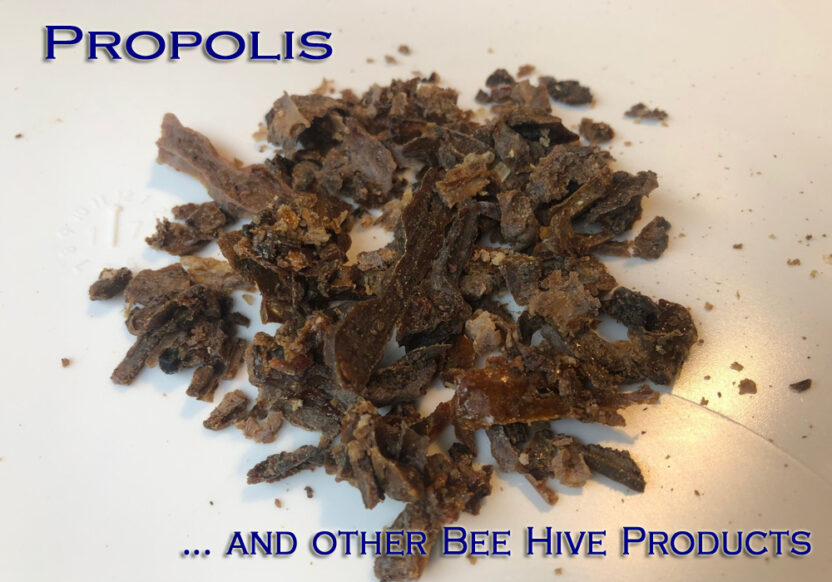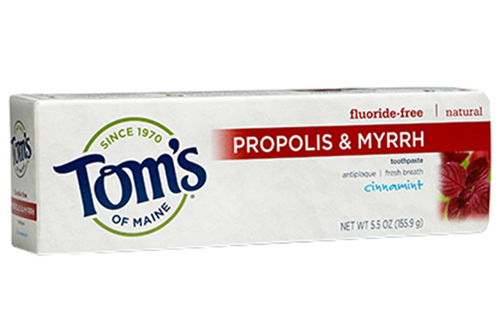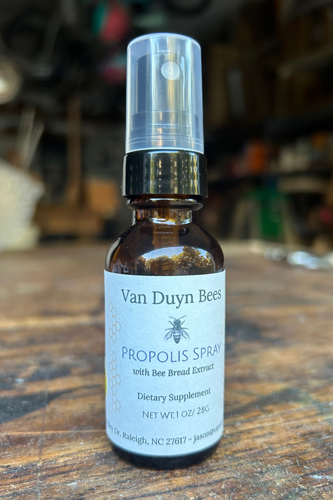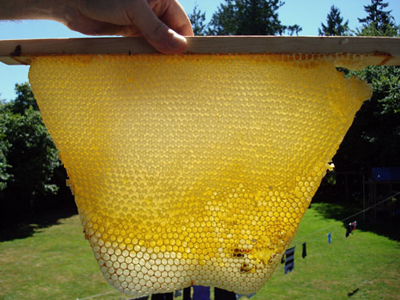 In the last year or so I have had more people looking for or asking about Propolis, mostly for medical reasons. Many people that I talk to are actually unaware that there is more than honey that just comes out of the hive. Honey and beeswax are the two things most people think about. However, there is bee pollen which differs from Bee Bread, Propolis, Royal Jelly, and Bee Venom are all collected. So Ill give a brief run down on each of these products. Then I will focus on Propolis as the heart of this article.
In the last year or so I have had more people looking for or asking about Propolis, mostly for medical reasons. Many people that I talk to are actually unaware that there is more than honey that just comes out of the hive. Honey and beeswax are the two things most people think about. However, there is bee pollen which differs from Bee Bread, Propolis, Royal Jelly, and Bee Venom are all collected. So Ill give a brief run down on each of these products. Then I will focus on Propolis as the heart of this article.
Bees Wax
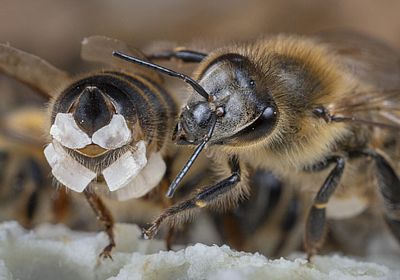
Honey Bee (Apis mellifera) worker collecting wax scales produced by another worker to build comb, Germany
Honey bees have wax glands on the underside of their abdomen. If you were to get close up on them, especially newer bees in the spring of the year you would see these scales of wax forming. They are very light in color at this point. As bees get older the glands become less active. Wax production is left to younger and newly emerged bees. Honeybees use the wax as their building material to build comb that holds brood, honey, and pollen.
Honey
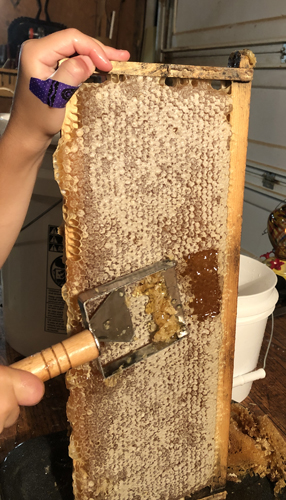 Honey is plant nectar that honey bees gather and store in their comb for use down the road. Honeybees consume plant nectar as their carbohydrate source. In its raw state the nectar has too much water to be of use later in the year. Honeycomb is filled up with this collected nectar and the bees circulate air through the colony to reduce the moisture content in the nectar. Once the moisture content is reduced, the bees will put a layer of wax over the cells (capping) to seal the comb off. In this condition honey will hold indefinitely. So long as the moisture content remains low enough that yeasts do not become active. Honey is hydroscopic, meaning it will pull water out of the air if left exposed. If the moisture content in honey becomes too high then the honey will ferment.
Honey is plant nectar that honey bees gather and store in their comb for use down the road. Honeybees consume plant nectar as their carbohydrate source. In its raw state the nectar has too much water to be of use later in the year. Honeycomb is filled up with this collected nectar and the bees circulate air through the colony to reduce the moisture content in the nectar. Once the moisture content is reduced, the bees will put a layer of wax over the cells (capping) to seal the comb off. In this condition honey will hold indefinitely. So long as the moisture content remains low enough that yeasts do not become active. Honey is hydroscopic, meaning it will pull water out of the air if left exposed. If the moisture content in honey becomes too high then the honey will ferment.
Pollen
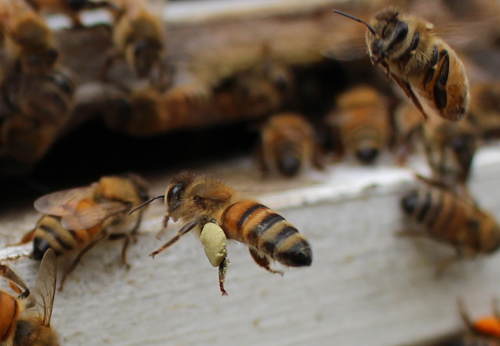
Honeybee Returning with Loaded Pollen Baskets
Also collected from plants and it makes up the other main portion of the honey bee diet. Pollen is collected as the honey bee protein source. It is primarily fed to young larva and a hive consumes more during the spring time as the brood rearing is at its height. Honey bees have special baskets on their hind legs where they collect pollen during foraging. Bee pollen that you may have seen marketed is typically collected by devices know as pollen traps. Pollen is scrapped off the bees legs as they enter the hive.
Bee Bread
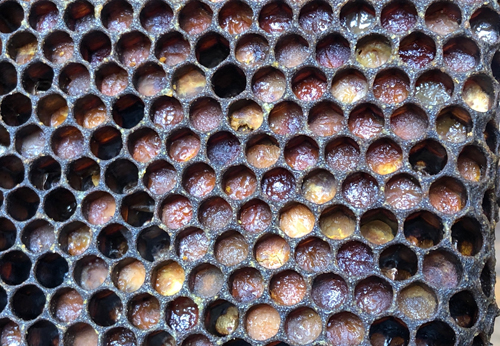
Bee Bread in Comb
Is a product that most people have never heard of. It differs from bee pollen as it is the pollen that makes its way into the hive. It is stored in the cells for use later when it is needed. Bee bread is made by the bees layering pollen and nectar to form these pellets. Pollen is put into a cell, then a little nectar, then more pollen, more nectar, and so on. The bees then ram all of this composite in the cells with their heads forming these compressed pollen pellets. Looking at a cross section of bee bread it’s common to see the differing layers of pollen as they are often different colors. This indicates the different types of plant pollen the bees are collecting.
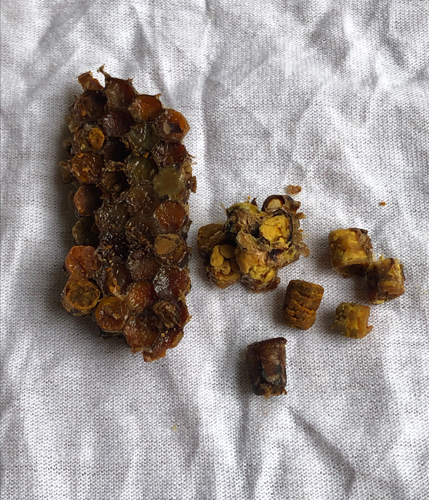
Bee Bread Cross Section
The addition of the nectar causes the pollen to ferment which preserves the nutritional quality of the pollen. Plant pollen I have read oxidizes rather quickly, something around 24-48 hours, which reduces its nutritional quality. Bee bread is the most concentrated pollen product. It retains more of its nutritional composition and bioactive compounds than “bee pollen”.
You may wonder, well why have I never heard of this then? Outside from one seller on amazon no one basically sells it. Sometimes you will see it referred as “perga” and often it is source of origin is eastern Europe. In those locations there is more of a tradition of its use. Bee Bread is rarely offered as the predominant management method in keeping bees prevents its collection. Treating hives to control varroa mite populations is common practice. This is done by applying pesticides to a hive through various forms. The treatment contaminates whatever is in the hive. Beekeepers remove their supers of honey before treating to avoid the contamination of their honey. However, since bee bread is often found close to the brood rearing portion of a colony, the beekeeper cannot separate that without also separating the brood. Varroa also happens to reproduce in those areas. All that said, it’s only possible to find be bread from a bee keeper that does not apply chemicals to their hives. That is, unless, the beekeeper is selling contaminated bee bread. Since I don’t treat my hives, I can save my frames of bee bread from colonies that didn’t survive the winter.
Royal Jelly
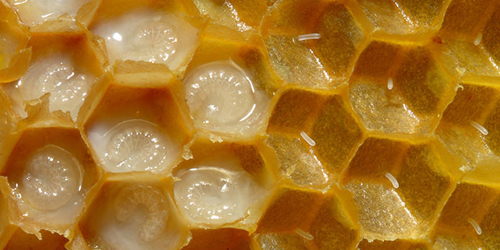
Honey Bee Larva Swimming in Royal Jelly – BeeHiveHero.com
You can think of this more like baby food for bee larva. It’s a secretion that is fed to all larva in the first three days or so after hatching. A queen lays eggs, which will take about 3-4 days to hatch. After that those young larva swim in a pool of royal jelly for about three days. Following the royal jelly diet larva are fed other things, primarily nectar and pollen. All larva, those that are destine to become drones, worker bees, or queens are fed royal jelly. Larva that are being raised as future queens continue to get fed royal jelly beyond the third day. The increased feeding triggers the development of queen morphology. If I recall correctly the amount of royal jelly fed to a larva is one of the main factors that separates male from female bees. Additionally, female bees that are fed more royal jelly, i.e. queens, have had sufficient amount to fully develop their ovaries.
Bee Venom
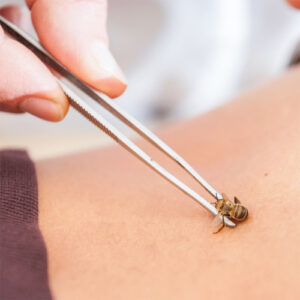 This is the venom that comes from bees, i.e. delivered through their stingers. Bee venom has interest in various medical circles. Primarily as the venom is purported to have high concentrations of antifungal properties. Its more common heard about in eastern medicine in the form of bee venom acupuncture. I had one person contact me recently that asked if they could purchase a small number of live bees. This is an unusual request and turns out they were looking into using bee venom to treat cronic lyme disease.
This is the venom that comes from bees, i.e. delivered through their stingers. Bee venom has interest in various medical circles. Primarily as the venom is purported to have high concentrations of antifungal properties. Its more common heard about in eastern medicine in the form of bee venom acupuncture. I had one person contact me recently that asked if they could purchase a small number of live bees. This is an unusual request and turns out they were looking into using bee venom to treat cronic lyme disease.
Propolis
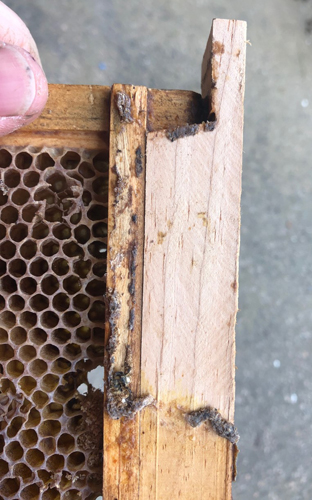
Propolis Attached to Hive Parts
Can be generally thought of as bee glue. Honey bees collect more than just nectar and pollen. They primarily collect water but also other things that make up their micronutrient needs. For instance its common to see bees working saw dust, and licking up salt. A few years ago I had honeybee drinking the sweat out of my shirt. Most recently I have seen them working the seed in a bird feeder. Propolis however is collected from various plant resins, trees being a large contributor. Its reported that raw propolis’s composition is made up of 50% resins, 30% wax, 10% essential oils, 5% pollen, and 5% other compounds. Propolis color varies based upon the source of plant resins, and is widely variable. Much of the literature I see suggests that propolis is collected primarily from the populus species. I am sure is true for various parts of the world. In my area however those species of plant are very uncommon so the bees are obviously collecting it from other places.
Honeybees use this sticky resin composite to coat everything in a hive. Most commonly it is used to glue frames of comb together and to plaster off smooth, irregular, or too large of voids in a hive. Working a bee hive, especially in the summer propolis gets everywhere, as it becomes pliable to very sticky as temperature increases. Some hives in particular are prolific generators of propolis, as it is all over the place. In some circles of beekeeping there are breeders that try and find bees that don’t use too much propolis as it is an inconvenience to beekeepers. This we are starting to learn may be a grievous error.
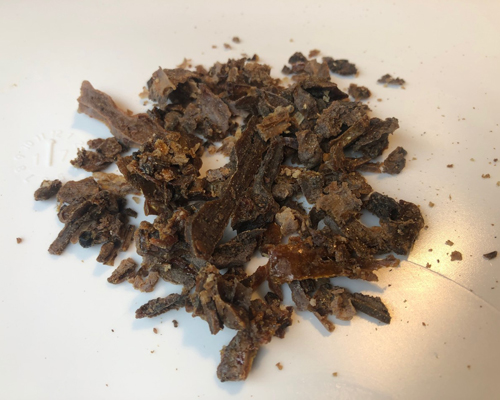
Collected Propolis Chunks
In recent years it has been discovered that propolis has lots of anti-inflammatory, anti-bacterial, anti-fungal, anti-viral, and anti cancerous qualities. The anti-inflammatory/anti-oxidative properties are due to its concentration of polyphenols, benzoic acids, cinnamic compounds, sesquiterpene/triterpene hydrocarbons, benzaldehyde derivatives, as well as various other acids, alcohols, ketones, etc. In fact, feral colonies in particular are known to create a propolis envelope around the interior cavity of a tree. Since tree cavities are very irregular, honey bees coat large portions of the inside of the hive with propolis. Bee hives are also extremely humid environments, so its common for water vapor to condense on the interior walls of a bee hive. In these feral hives the condensed water forms on the propolis envelope and thus scavenging some of the medicinal qualities of propolis. Honey bees rehydrate stored honey before consumption so they will often drink this condensed water since its right there in the hive. Doing so they in effect medicate themselves. From a beekeeper standpoint, there has been some effort to encourage honeybees to form this propolis envelope in managed hives.
Propolis products
In the last few years there have been more propolis products entering the marketplace. Most commonly is a propolis tincture (extract) and propolis throat spray. Less common are propolis salves, mouthwashes, toothpastes, balms, etc. Propolis is solid at room temperature, and while people use it in raw form for various ailments it is more easily useful in liquid form. Thus there have been several mediums to make propolis extract, e.g. alcohol, oil, and water bases. Each of these have varying degrees of scavenging ability. Literature that I have found suggests that alcohol and water/glycol mediums have the highest concentration of bioactive compounds.
I started collecting propolis in the last few year as I had request for it from people seeking to use it as a companion treatment with chemo therapies, allergies, mold toxicity, etc. There were some studies that suggested that it lessened the negative effects of various chemo/radiation treatments. More recently I have used propolis throat spray and decided to look into propolis studies more in depth. Ill expound more on those studies findings in another article.
Sourcing Propolis
There is a fair amount of literature that delves into the various types and amounts of polyphenols, flavonoids, and other anti oxidative compounds found in propolis. That literature shows its effectiveness is inhibiting germ positive and germ negative bacteria cultures (amongst other things), so I think there is definitely something to its effectiveness. The big problem in all this is, as with any honey product, is that no one can conclusively say that it is effective. That’s true for raw honey/bee bread/bee pollen for allergies, honey used topically for wound treatment, or propolis use for the various treatments that have been developed. There are studies that point to effectiveness but there are no or very little clinical trials for example that say yes this absolutely works.
That said, now that I have been selling honey for a while, I do have lots of people that report it definitely worked in improving their allergy issues. I imagine the same is true for products developed with bee bread, propolis, or royal jelly. Given that I decided to make my own propolis spray, and here are the main reasons why.
Sourcing is everything…
Honeybees collect propolis from everything, though most of the products on the market come from places far from at least where I am. Beekeeping is very local so getting propolis or any bee product rather is better the closer your are to the source. Mainly, you are potentially able to see what the beekeepers managing practices are.
Why is this important? Well… beeswax in a hive acts like a liver, it absorbs lots of chemicals, that being those found in the environment and those introduced by the beekeeper. It turns out that propolis is like this if even more so. There are studies that look at the chemical and heavy metal concentration of propolis. Heavy metal concentration is going to mainly come from environmental pollutants. Probably not so big of a deal in lots of places, unless the bees are near places that are heavily polluted. Personally, it makes me wary of any bee product coming out of China. Most places heavy metal contamination isn’t a big problem though.
Treatment for varroa mites is what gives me concern. Similarly to issues brought up in bee bread it would not surprise me to see that a lot of the propolis products on the market were derived from contaminated propolis. Those that are actively collecting propolis do so with the use of sheets they put on the hive to promote propolis deposition. It could easily be removed before treatments, though I have no idea what the propolis source of these products are, nor the beekeeper practices. Many I imagine are coming from half way around the world and bee product adulteration is a real issue. Even with propolis there are those that collect tulip gum resin as it mimics propolis in some properties and is sold as propolis. This doesn’t even get into what the concentration of the propolis extract is in these products. Most of the labelling information doesn’t give a good idea as to which products have more active ingredient. Some are good, some not so much.
So for me I decided to start making propolis extracts as I am certain the propolis I use is void of beekeeper introduced chemicals and the bees aren’t kept near high polluted areas. The same is also true of the honey and other bee products. Nowadays I think people are increasingly more interested in knowing the source of their foods/nutrition and how those products were raised, grown, or made.
Go Here if you are interested in ordering chemical free Propolis Spray or other honey products.

